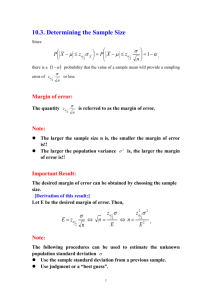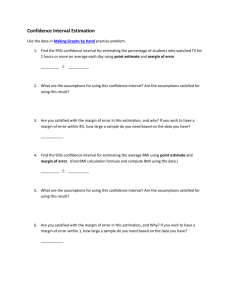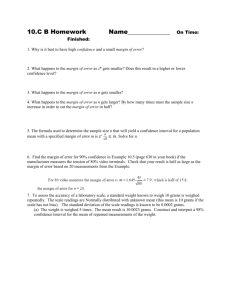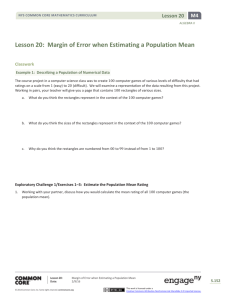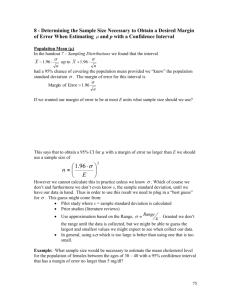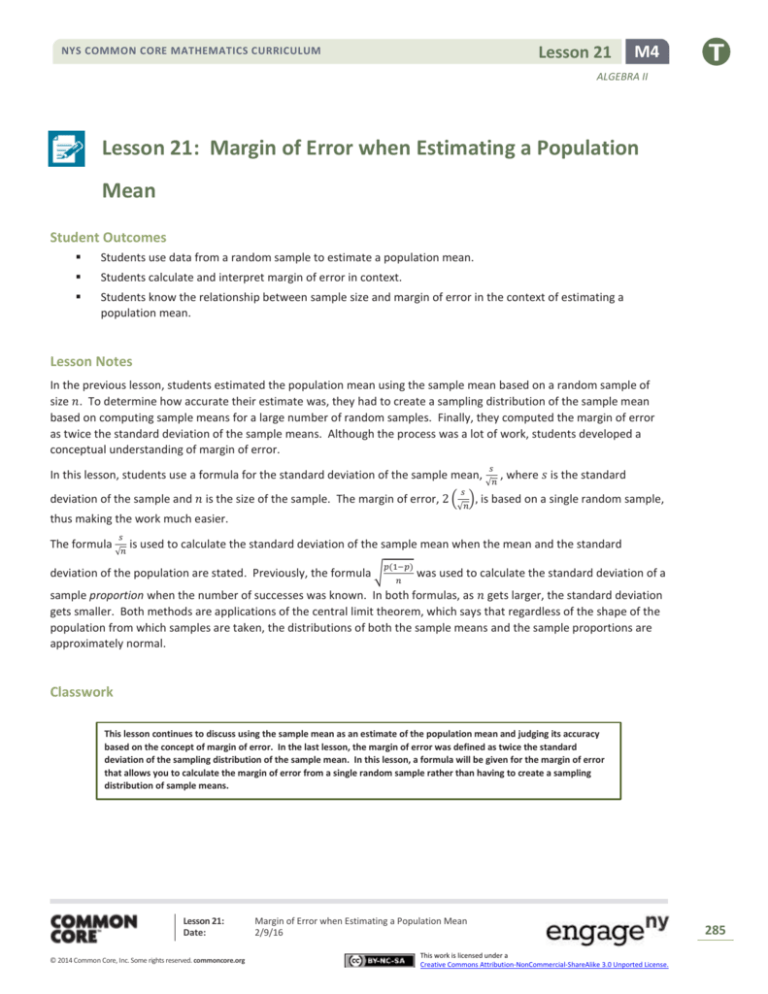
Lesson 21
NYS COMMON CORE MATHEMATICS CURRICULUM
M4
ALGEBRA II
Lesson 21: Margin of Error when Estimating a Population
Mean
Student Outcomes
Students use data from a random sample to estimate a population mean.
Students calculate and interpret margin of error in context.
Students know the relationship between sample size and margin of error in the context of estimating a
population mean.
Lesson Notes
In the previous lesson, students estimated the population mean using the sample mean based on a random sample of
size 𝑛. To determine how accurate their estimate was, they had to create a sampling distribution of the sample mean
based on computing sample means for a large number of random samples. Finally, they computed the margin of error
as twice the standard deviation of the sample means. Although the process was a lot of work, students developed a
conceptual understanding of margin of error.
In this lesson, students use a formula for the standard deviation of the sample mean,
𝑠
√𝑛
, where 𝑠 is the standard
𝑠
deviation of the sample and 𝑛 is the size of the sample. The margin of error, 2 ( ), is based on a single random sample,
√𝑛
thus making the work much easier.
The formula
𝑠
√𝑛
is used to calculate the standard deviation of the sample mean when the mean and the standard
deviation of the population are stated. Previously, the formula √
𝑝(1−𝑝)
𝑛
was used to calculate the standard deviation of a
sample proportion when the number of successes was known. In both formulas, as 𝑛 gets larger, the standard deviation
gets smaller. Both methods are applications of the central limit theorem, which says that regardless of the shape of the
population from which samples are taken, the distributions of both the sample means and the sample proportions are
approximately normal.
Classwork
This lesson continues to discuss using the sample mean as an estimate of the population mean and judging its accuracy
based on the concept of margin of error. In the last lesson, the margin of error was defined as twice the standard
deviation of the sampling distribution of the sample mean. In this lesson, a formula will be given for the margin of error
that allows you to calculate the margin of error from a single random sample rather than having to create a sampling
distribution of sample means.
Lesson 21:
Date:
© 2014 Common Core, Inc. Some rights reserved. commoncore.org
Margin of Error when Estimating a Population Mean
2/9/16
This work is licensed under a
Creative Commons Attribution-NonCommercial-ShareAlike 3.0 Unported License.
285
Lesson 21
NYS COMMON CORE MATHEMATICS CURRICULUM
M4
ALGEBRA II
Example 1 (5 minutes): Estimating a Population Mean Using a Random Sample
Give students a few minutes to read the introductory material of this example, and remind them of the process they
used in the previous lesson to get an estimate of margin of error. Then, write the formula for margin of error on the
MP.2 board, making sure that students understand that this will allow them to calculate an estimate of the margin of error
using data from a single random sample.
Example 1: Estimating a Population Mean Using a Random Sample
Provide a one-sentence summary of our findings from the previous lesson.
Sample response: We took lots of random samples of computer game ratings, computed their means, displayed the
distribution of their means, and, finally, computed a margin of error.
What were drawbacks of the calculation method?
Sample response: Many samples are required. If we had increased the sample size or the number of samples, the time
required to take all those samples, calculate their means, and analyze the distribution would have increased significantly.
Scaffolding:
In practice, you do not have to use that process to find the margin of error. Fortunately, just as was
the case with estimating a population proportion, there are some general results that lead to a
formula that allows you to estimate the margin of error using a single sample. You can then gauge
the accuracy of your estimate of the population mean by calculating the margin of error using the
sample standard deviation.
The standard deviation of the distribution of sample means is approximated by
𝒔
√𝒏
, where 𝒔 is the standard deviation of the sample, and 𝒏 is the size of the sample.
Exercises 1–5 (10 minutes)
Have students work independently on the calculations required to answer Exercises 1–3.
Then, work through Exercises 4 and 5 as a class.
Exercises 1–5
1.
Suppose a random sample of size ten produced the following ratings in the computer games
rating example in the last lesson: 𝟏𝟐, 𝟓, 𝟐, 𝟒, 𝟏, 𝟒, 𝟏𝟖, 𝟏𝟎, 𝟏, 𝟏𝟔. Estimate the population mean
rating based on these ten sampled ratings.
The sample mean estimate for the population mean rating is
2.
𝟕𝟑
𝟏𝟎
= 𝟕. 𝟑 rating points.
Calculate the sample standard deviation. Round your answer to three decimal places.
The sample standard deviation is 𝟔. 𝟐𝟕𝟐𝟓 rating points.
For struggling students –
the bigger the value of 𝑛,
the smaller the standard
deviation. From a
population where 𝑠 = 2, if
𝑛 = 36, the standard
1
deviation is ; however, if
3
the sample is larger, say
81, the standard deviation
2
would be .
9
For advanced students –
when a sample is taken
from a population, the
mean of the sample is the
same as the mean of the
population, but the
variance (square of the
standard deviation) is only
1
as large. Regardless of
𝑛
the shape of the
population, the
distribution of the sample
means will approach
normal (central limit
theorem). The variance is
𝑠2
; therefore, by applying a
𝑛
square root, the standard
𝑠
deviation is .
√𝑛
Lesson 21:
Date:
© 2014 Common Core, Inc. Some rights reserved. commoncore.org
Margin of Error when Estimating a Population Mean
2/9/16
This work is licensed under a
Creative Commons Attribution-NonCommercial-ShareAlike 3.0 Unported License.
286
Lesson 21
NYS COMMON CORE MATHEMATICS CURRICULUM
M4
ALGEBRA II
3.
Use the formula given above to calculate the approximate standard deviation of the distribution of sample means.
Round your answer to three decimal places.
The standard deviation of the distribution of sample means is
4.
𝒔
√𝒏
=
𝟔.𝟐𝟕𝟑
√𝟏𝟎
= 𝟏. 𝟗𝟖𝟒 rating points.
Recall that the margin of error is twice the standard deviation of the distribution of sample means. What is the
value of the margin of error based on this sample? Write a sentence interpreting the value of the margin of error in
the context of this problem on computer game ratings.
Margin of error is 𝟐(𝟏. 𝟗𝟖𝟒) = 𝟑. 𝟗𝟔𝟖 rating points. The population mean rating for the 𝟏𝟎𝟎 computer games is
likely to be within 𝟑. 𝟗𝟔𝟖 rating points of the sample mean estimate 𝟕. 𝟑.
5.
Based on the sample mean and the value of the margin of error, what is an interval of plausible values for the
population mean?
Plausible values for the population mean rating are from 𝟕. 𝟑 − 𝟑. 𝟗𝟔𝟖 = 𝟑. 𝟑𝟑𝟐 to 𝟕. 𝟑 + 𝟑. 𝟗𝟔𝟖 = 𝟏𝟏. 𝟐𝟔𝟖 rating
points.
Exercises 6–13 (20 minutes): The Gettysburg Address
Distribute a copy of the Gettysburg Address to each student in the class. (A copy is provided at the end of this lesson.)
Have students work individually or in pairs to answer the questions in this set of exercises. Then, discuss the answers to
the last question as a class. Consider challenging students to find the length of a typical word in the Gettysburg Address.
After students do this exercise “by hand” (using a calculator), you may want to show them an applet that displays three
different estimates regarding the Gettysburg Address. One is the mean word length. The other two are estimating
population proportions; one is the proportion of “long” words defined as words with more than four letters, and the
other is the proportion of nouns. The applet can be found at the following site:
http://www.rossmanchance.com/applets/GettysburgSample/GettysburgSample.html.
This applet may require an updated version of an operating system to work correctly. If the applet does not work for all
students due to a computer’s operating system or network settings, attempt to demonstrate it for the whole class, as it
is an effective way to complement how students obtained their answers in the exercises. The applet allows the user to
specify a sample size (ten in this exercise) and the number of samples desired. Note that only one sample is to be used
to answer the questions in this exercise set.
To generate a sampling distribution for the sample mean (or proportion), enter a large number in the Num samples box,
such as 500. The Animate box shows the observations for each sample taken and the resulting values of the statistics
(mean or proportion) plotted on a histogram. (You may unclick the Animate box at any time to see the total results
immediately.)
Students should begin work on Exercise 6. Exercises 7–13 are provided as scaffolding if necessary. Students should be
able to clearly describe and fully implement a plan on their own. Sample responses are provided but will vary.
Exercises 6-13
The Gettysburg Address is considered one of history’s greatest speeches. Some students noticed that the speech was
very short (about 𝟐𝟔𝟖 words, depending on the version) and wondered if the words were also relatively short. To
estimate the mean length of words in the population of words in the Gettysburg Address, work with a partner on the
following steps. Your teacher will give you a copy of the Gettysburg Address with words numbered from 𝟎𝟎𝟏 to 𝟐𝟔𝟖.
Lesson 21:
Date:
© 2014 Common Core, Inc. Some rights reserved. commoncore.org
Margin of Error when Estimating a Population Mean
2/9/16
This work is licensed under a
Creative Commons Attribution-NonCommercial-ShareAlike 3.0 Unported License.
287
Lesson 21
NYS COMMON CORE MATHEMATICS CURRICULUM
M4
ALGEBRA II
6.
Develop and describe a plan for collecting data from the Gettysburg Address and determining the typical length of a
word. Then, implement your plan, and report your findings.
Many answers are possible. Every answer should include the following:
MP.5
7.
A description of how a word sample is chosen, making sure to describe how randomization occurs
The actual sample chosen
Calculations of the sample mean, standard deviation, and margin of error
Interpretations in context of the sample mean, standard deviation, and margin of error
Use a random-number table or a calculator with a random-number generator to obtain ten different random
numbers from 𝟎𝟎𝟏 to 𝟐𝟔𝟖.
𝟐𝟏𝟗 𝟐𝟐𝟗 𝟐 𝟏𝟏𝟑 𝟕𝟕 𝟏𝟒𝟎 𝟏𝟖𝟓 𝟕𝟎 𝟏𝟏𝟗 𝟓𝟒
8.
9.
Use the random numbers found in Exercise 7 as identification numbers for the words that will make up your random
sample of words from the Gettysburg Address. Make a list of the ten words in your sample.
𝟐𝟏𝟗 − the
𝟏𝟒𝟎 − The
𝟐𝟐𝟗 − resolve
𝟏𝟖𝟓 − nobly
𝟐 − score
𝟕𝟎 − a
𝟏𝟏𝟑 − consecrate
𝟏𝟏𝟗 − The
𝟕𝟕 − final
𝟓𝟒 − endure
Count the number of letters in each of the ten words in your sample.
𝟑 𝟕 𝟓 𝟏𝟎 𝟓 𝟑 𝟓 𝟏 𝟑 𝟔
10. Calculate the sample mean number of letters for the ten words in your sample.
The mean of the ten word lengths from Exercise 9 is
𝟒𝟖
𝟏𝟎
= 𝟒. 𝟖 letters.
11. Calculate the sample standard deviation of the number of letters for the ten words in your sample. Round your
answer to three decimal places.
The standard deviation of the ten word lengths from Exercise 9 is 𝟐. 𝟓𝟑𝟎 letters.
12. Use the sample standard deviation from Exercise 11 to calculate the margin of error associated with using your
sample mean as an estimate of the population mean. Round your answer to three decimal places.
The margin of error of this estimate is 𝟐 (
MP.2
𝟐.𝟓𝟑𝟎
) = 𝟏. 𝟔𝟎𝟎 letters.
√𝟏𝟎
13. Write a few sentences describing what you have learned about the mean length of the population of 𝟐𝟔𝟖 words in
the Gettysburg Address. Be sure to include an interpretation of the margin of error.
We estimate the mean word length of words in the Gettysburg Address to be 𝟒. 𝟖 letters. The margin of error of this
estimate is 𝟏. 𝟔 letters. So, plausible values for the population mean word length are from 𝟑. 𝟐 to 𝟔. 𝟒 letters.
Lesson 21:
Date:
© 2014 Common Core, Inc. Some rights reserved. commoncore.org
Margin of Error when Estimating a Population Mean
2/9/16
This work is licensed under a
Creative Commons Attribution-NonCommercial-ShareAlike 3.0 Unported License.
288
Lesson 21
NYS COMMON CORE MATHEMATICS CURRICULUM
M4
ALGEBRA II
Closing (3 minutes)
Ask students to summarize the main ideas of the lesson in writing or with a neighbor. Use this as an
opportunity to informally assess comprehension of the lesson. The Lesson Summary below offers some
important ideas that should be included.
Lesson Summary
When using the sample mean to estimate a population mean, it is important to know something about
how accurate that estimate might be.
Accuracy can be described by the margin of error.
The margin of error can be estimated using data from a single random sample (without the need to
create a simulated sampling distribution) by using the formula 𝟐 (
𝒔
√𝒏
), where 𝒔 is the standard
deviation of a single sample, and 𝒏 is the sample size.
Exit Ticket (7 minutes)
Lesson 21:
Date:
© 2014 Common Core, Inc. Some rights reserved. commoncore.org
Margin of Error when Estimating a Population Mean
2/9/16
This work is licensed under a
Creative Commons Attribution-NonCommercial-ShareAlike 3.0 Unported License.
289
Lesson 21
NYS COMMON CORE MATHEMATICS CURRICULUM
M4
ALGEBRA II
Name
Date
Lesson 21: Margin of Error when Estimating a Population Mean
Exit Ticket
A Health Group study recommends that the total weight of a male student’s backpack should not be more that 15% of
his body weight. For example, if a student weighs 170 pounds, his backpack should not weigh more than 25.5 pounds.
Suppose that ten randomly selected eleventh grade boys produced the following data:
Body weight
Backpack weight
155
29.8
136
27.2
197
32.5
174
34.8
165
31.8
165
28.8
150
31.1
142
26.0
176
28.3
157
31.4
a.
For each student, calculate backpack weight as a percentage of body weight (round to one decimal place).
b.
Based on the data in part (a), estimate the mean percentage of body weight that eleventh grade boys carry in
their backpacks.
c.
Find the margin of error for your estimate of part (b). Round your answer to three decimal places. Explain
how you determined your answer.
d.
Comment on the amount of weight eleventh grade boys at this school are carrying in their backpacks
compared to the recommendation by the Health Group.
Lesson 21:
Date:
© 2014 Common Core, Inc. Some rights reserved. commoncore.org
Margin of Error when Estimating a Population Mean
2/9/16
This work is licensed under a
Creative Commons Attribution-NonCommercial-ShareAlike 3.0 Unported License.
290
Lesson 21
NYS COMMON CORE MATHEMATICS CURRICULUM
M4
ALGEBRA II
Exit Ticket Sample Solutions
A Health Group study recommends that the total weight of a male student’s backpack should not be more that 𝟏𝟓% of
his body weight. For example, if a student weighs 𝟏𝟕𝟎 pounds, his backpack should not weigh more than 𝟐𝟓. 𝟓 pounds.
Suppose that ten randomly selected eleventh grade boys produced the following data:
Body weight
Backpack weight
a.
𝟏𝟓𝟓
𝟐𝟗. 𝟖
𝟏𝟗𝟕
𝟑𝟐. 𝟓
𝟏𝟕𝟒
𝟑𝟒. 𝟖
𝟏𝟔𝟓
𝟑𝟏. 𝟖
𝟏𝟔𝟓
𝟐𝟖. 𝟖
𝟏𝟓𝟎
𝟑𝟏. 𝟏
𝟏𝟒𝟐
𝟐𝟔. 𝟎
𝟏𝟕𝟔
𝟐𝟖. 𝟑
𝟏𝟓𝟕
𝟑𝟏. 𝟒
For each student, calculate backpack weight as a percentage of body weight (round to one decimal place).
Body weight
Backpack weight
Percentage
b.
𝟏𝟑𝟔
𝟐𝟕. 𝟐
𝟏𝟓𝟓
𝟐𝟗. 𝟖
𝟏𝟗. 𝟐
𝟏𝟑𝟔
𝟐𝟕. 𝟐
𝟐𝟎. 𝟎
𝟏𝟗𝟕
𝟑𝟐. 𝟓
𝟏𝟔. 𝟓
𝟏𝟕𝟒
𝟑𝟒. 𝟖
𝟐𝟎. 𝟎
𝟏𝟔𝟓
𝟑𝟏. 𝟖
𝟏𝟗. 𝟑
𝟏𝟔𝟓
𝟐𝟖. 𝟖
𝟏𝟕. 𝟓
𝟏𝟓𝟎
𝟑𝟏. 𝟏
𝟐𝟎. 𝟕
𝟏𝟒𝟐
𝟐𝟔. 𝟎
𝟏𝟖. 𝟑
𝟏𝟕𝟔
𝟐𝟖. 𝟑
𝟏𝟔. 𝟏
𝟏𝟓𝟕
𝟐𝟏. 𝟒
𝟏𝟑. 𝟔
Based on the data in part (a), estimate the mean percentage of body weight that eleventh grade boys carry in
their backpacks.
The sample mean percentage is 𝟏𝟖. 𝟏𝟐 percentage points.
c.
Find the margin of error for your estimate of part (b). Explain how you determined your answer.
The standard deviation of the percentages is 𝟐. 𝟐𝟎𝟕 percent. So, the margin of error is 𝟐 (
𝟐.𝟐𝟎𝟕
)=
√𝟏𝟎
𝟏. 𝟑𝟗𝟔 percentage points.
d.
Comment on the amount of weight eleventh grade boys at this school are carrying in their backpacks
compared to the recommendation by the Health Group.
Based on the data in this study, plausible percentages of mean body weight percentage that eleventh graders
are carrying in their backpacks are 𝟏𝟖. 𝟏𝟐 − 𝟏. 𝟑𝟗𝟔 = 𝟏𝟔. 𝟕𝟐𝟒 to 𝟏𝟖. 𝟏𝟐 + 𝟏. 𝟑𝟗𝟔 = 𝟏𝟗. 𝟓𝟏𝟔 percentage
points. The interval (𝟏𝟔. 𝟕𝟐𝟒%, 𝟏𝟗. 𝟓𝟏𝟔%) is above the recommended 𝟏𝟓% maximum. On average,
eleventh grade boys at this school are carrying too much weight in their backpacks.
Problem Set Sample Solutions
1.
A new brand of hot dog claims to have a lower sodium content than the leading brand.
a.
A random sample of ten of these new hot dogs results in the following sodium measurements (mg).
𝟑𝟕𝟎 𝟑𝟐𝟔 𝟑𝟐𝟐 𝟐𝟗𝟕 𝟑𝟐𝟔 𝟐𝟖𝟗 𝟐𝟗𝟑 𝟐𝟔𝟒 𝟑𝟐𝟕 𝟑𝟑𝟏
Estimate the population mean sodium content of this new brand of hot dog based on the ten sampled
measurements.
Based on the data, an estimate for the population mean sodium content of this new brand of hot dog is
𝟑𝟏𝟒. 𝟓 mg of sodium.
b.
Calculate the margin of error associated with your estimate of the population mean from part (a). Round
your answer to three decimal places.
The margin of error is 𝟐 (
Lesson 21:
Date:
© 2014 Common Core, Inc. Some rights reserved. commoncore.org
𝟐𝟗.𝟒𝟑𝟔
) = 𝟏𝟖. 𝟔𝟏𝟕 mg.
√𝟏𝟎
Margin of Error when Estimating a Population Mean
2/9/16
This work is licensed under a
Creative Commons Attribution-NonCommercial-ShareAlike 3.0 Unported License.
291
Lesson 21
NYS COMMON CORE MATHEMATICS CURRICULUM
M4
ALGEBRA II
c.
The mean sodium content of the leading brand of hot dogs is known to be 𝟑𝟓𝟎 mg. Based on the sample
mean and the value of the margin of error for the new brand, is a mean sodium content of 𝟑𝟓𝟎 mg a
plausible value for the mean sodium content of the new brand? Comment on whether you think the new
brand of hot dog has a lower sodium content on average than the leading brand.
Plausible values for population mean sodium content are between 𝟑𝟏𝟒. 𝟓 − 𝟏𝟖. 𝟔𝟏𝟕 = 𝟐𝟗𝟓. 𝟖𝟖𝟑 mg and
𝟑𝟏𝟒. 𝟓 + 𝟏𝟖. 𝟔𝟏𝟕 = 𝟑𝟑𝟑. 𝟏𝟏𝟕 mg. This interval is well below the 𝟑𝟓𝟎 mg which is the mg content for the
leading brand. So, the new hot dog brand has lower mean sodium content.
d.
Another random sample of 𝟒𝟎 new brand hot dogs is taken. Should this larger sample of hot dogs produce a
more accurate estimate of the population mean sodium content than the sample of size 𝟏𝟎? Explain your
answer by appealing to the formula for margin of error.
The margin of error will be smaller. Sample size is in the denominator of formula for margin of error.
2.
It is well known that astronauts increase their height in space missions because of the lack of gravity. A question is
whether or not we increase height here on Earth when we are put into a situation where the effect of gravity is
minimized. In particular, do people grow taller when confined to a bed? A study was done in which the heights of
six men were taken before and after they were confined to bed for three full days.
a.
The before-after differences in height measurements (mm) for the six men were:
𝟏𝟐. 𝟔 𝟏𝟒. 𝟒 𝟏𝟒. 𝟕 𝟏𝟒. 𝟓 𝟏𝟓. 𝟐 𝟏𝟑. 𝟓.
Assuming that the men in this study are representative of the population of all men, what is an estimate of
the population mean increase in height after three full days in bed?
Based on the given data, an estimate of the population mean increase in height after three full days in bed is
𝟏𝟒. 𝟏𝟓 mm.
b.
Calculate the margin of error associated with your estimate of the population mean from part (a). Round
your answer to three decimal places.
The margin of error is approximated by 𝟐 (
c.
𝟎.𝟗𝟒𝟎
) = 𝟎. 𝟕𝟔𝟖 mm.
√𝟔
Based on your sample mean and the margin of error from parts (a) and (b), what are plausible values for the
population mean height increase for all men who stay in bed for three full days?
Plausible values for the population mean height increase for all men who stay in bed for three full days are
those between 𝟏𝟒. 𝟏𝟓 − 𝟎. 𝟕𝟔𝟖 = 𝟏𝟑. 𝟑𝟖𝟐 and 𝟏𝟒. 𝟏𝟓 + 𝟎. 𝟕𝟔𝟖 = 𝟏𝟒. 𝟗𝟏𝟖 mm.
Lesson 21:
Date:
© 2014 Common Core, Inc. Some rights reserved. commoncore.org
Margin of Error when Estimating a Population Mean
2/9/16
This work is licensed under a
Creative Commons Attribution-NonCommercial-ShareAlike 3.0 Unported License.
292
Lesson 21
NYS COMMON CORE MATHEMATICS CURRICULUM
M4
ALGEBRA II
Exercises 6-13: Gettysburg Address
001 Four
002 score
003 and
004 seven
005 years
006 ago,
007 our
008 fathers
009 brought
010 forth
011 upon
012 this
013 continent
014 a
015 new
016 nation;
017 conceived
018 in
019 liberty,
020 and
021 dedicated
022 to
023 the
024 proposition
025 that
026 all
027 men
028 are
029 created
030 equal.
031 Now
032 we
033 are
034 engaged
035 in
036 a
037 great
038 civil
039 war,
040 testing
041 whether
042 that
043 nation,
044 or
045 any
046 nation,
047 so
048 conceived
049 and
050 so
051 dedicated,
052 can
053 long
054 endure.
055 We
056 are
057 met
058 on
059 a
060 great
061 battlefield
062 of
063 that
064 war.
065 We
066 have
067 come
068 to
069 dedicate
070 a
071 portion
072 of
073 that
074 field
075 as
076 a
077 final
078 resting
079 place
080 for
081 those
082 who
083 here
084 gave
085 their
086 lives
087 that
088 that
Lesson 21:
Date:
© 2014 Common Core, Inc. Some rights reserved. commoncore.org
089 nation
090 might
091 live.
092 It
093 is
094 altogether
095 fitting
096 and
097 proper
098 that
099 we
100 should
101 do
102 this.
103 But,
104 in
105 a
106 larger
107 sense,
108 we
109 cannot
110 dedicate,
111 we
112 cannot
113 consecrate,
114 we
115 cannot
116 hallow
117 this
118 ground.
119 The
120 brave
121 men,
122 living
123 and
124 dead,
125 who
126 struggled
127 here
128 have
129 consecrated
130 it,
131 far
132 above
133 our
134 poor
135 power
136 to
137 add
138 or
139 detract.
140 The
141 world
142 will
143 little
144 note,
145 nor
146 long
147 remember,
148 what
149 we
150 say
151 here,
152 but
153 it
154 can
155 never
156 forget
157 what
158 they
159 did
160 here.
161 It
162 is
163 for
164 us
165 the
166 living,
167 rather,
168 to
169 be
170 dedicated
171 here
172 to
173 the
174 unfinished
175 work
176 which
177 they
178 who
179 fought
180 here
181 have
182 thus
183 far
184 so
185 nobly
186 advanced.
187 It
188 is
189 rather
190 for
191 us
192 to
193 be
194 here
195 dedicated
196 to
197 the
198 great
199 task
200 remaining
201 before
202 us,
203 that
204 from
205 these
206 honored
207 dead
208 we
209 take
210 increased
211 devotion
212 to
213 that
214 cause
215 for
216 which
217 they
218 gave
219 the
220 last
221 full
222 measure
223 of
224 devotion,
225 that
226 we
227 here
228 highly
229 resolve
230 that
231 these
232 dead
233 shall
234 not
235 have
236 died
237 in
238 vain,
239 that
240 this
241 nation,
242 under
243 God,
244 shall
245 have
246 a
247 new
248 birth
249 of
250 freedom,
251 and
252 that
253 government
254 of
255 the
256 people,
257 by
258 the
259 people,
260 for
261 the
262 people,
263 shall
264 not
265 perish
266 from
267 the
268 earth.
Margin of Error when Estimating a Population Mean
2/9/16
This work is licensed under a
Creative Commons Attribution-NonCommercial-ShareAlike 3.0 Unported License.
293




